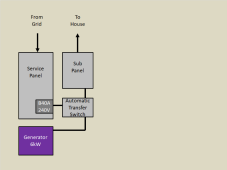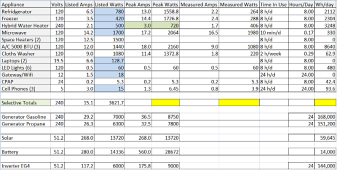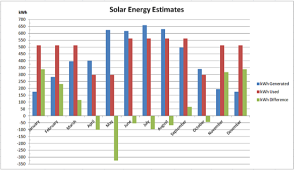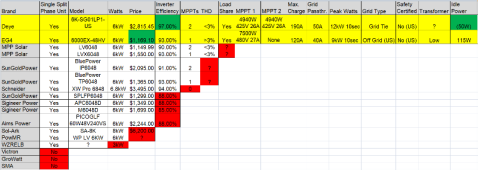rebelrider.mike
New Member
Hi all.
I'm looking into installing a sub panel next to my main panel. As I've been upgrading my old house, I've been adding more and more circuit breakers because of codes and such. I'm actually trying to use less power. But my main panel is getting full.
I'd like to add a backup generator and transfer switch to the sub panel, and later a battery/inverter setup and maybe even some solar. I know a bit about solar, and a lot about batteries, but very little about inverters. I have a "small" battery that can run a mini fridge for several days on a single charge using a WZRELB inverter.
I'm on the US power grid, so split phase 240V. I don't plan to have any 240V appliances on the sub panel. I am thinking I'll want 8 circuits and up to 6kW available. That translates to 50A at 120V, or 25A at 240V. I don't plan on sending power back to the grid for money. Though that is an option in my area. Not sure how much solar power I'll actually be generating. We got 136 inches of rain last year.
I've watched hours of videos, and read through reams of web pages and PDF files. Though I'm learning a lot, it's all very confusing and I don't know how to translate it into buying stuff that will work for my particular system. I think I need a split phase inverter since my power requirement is too high. I'm using the grid as the primary source of power for now until I get solar installed. That could be years away though. It would be nice to power the sub panel from solar with the grid as a supplement/backup for when the solar/battery can't provide all the power.
I don't plan to use any power tools or well pumps. So I don't need a low frequency inverter. It's odd; I keep hearing that inverters are commonly high frequency, yet almost all the ones I've seen for sale are low frequency. Does it even matter?
Here's a list of things I'd "need" to have on backup power, assuming that things like cell towers and ISPs are still working:
Fridge: 6.5A 780W (2.2A 264W)
Freezer: 3.5A 420W
Laptops: 19.5V 3.3A (x2) 128.7W
Cell Phones: 0.5W (x3) 1.5W
Gateway: 18W
Router: 9W
Wifi: 18W
CPAP: 5.3W
If there's no internet or cell towers working, I suppose the various electronics become unnecessary. 1380.5W total.
Here's more things I'd really like to have, assuming I can generate the power, and if water is available. My community has until the water tower is empty before the taps quit working.
Microwave (input): 1700W
Cloths washer: 9A 1080W
120V heaters: 750W (x2) 1500W
5,000 BTU A/C: 4A (x4) 1900W
Lights: 10W (x6) 60W
6240W total. Though one could lower this by not running the microwave and washing machine at the same time. Or turn of the heaters or some of the A/C units. And we'd certainly not run the A/Cs and heaters at the same time. So more like 3660W.
Let's say it's hot out and we're running all 4 A/C units. Laptops are on, but fully charged so only using half of their total power. Maybe a couple lights are on. And we decide to heat something up in the microwave. Total would be 3730.5W. If the fridge and the freezer happened to be running at the same time, that would be 4930.5W. About 82% of the capacity of a 6000W inverter.
I could install the generator, transfer switch, and sub panel as early as this year. No point in getting an inverter right a way. I have no batteries for it yet. That's a whole other project. In fact, I started thinking about this stuff back in 2017. But I've been focused on making my old house more energy efficient with modern NEC compliant wiring.
I picked out a 6kW dual fuel inverter generator. I don't plan to have automatic switching between the grid and generator. I spent many hours trying to figure out exactly how it works (not just the theory) and came up with nothing. My electronics have their own UPSs anyway so it doesn't matter.
With the generator installed, the priority would be grid, then generator obviously.
With the battery and inverter added, the priority would be grid, then battery, then generator.
With solar added it changes up a bit. Solar, then battery, then grid, then generator.
I've read that some inverters will use solar/battery and grid at the same time. Using the grid only to make up for a lack of power from solar. I don't know which ones those are though. Would be neat if possible.
I've got a long list of inverters I've been looking at. Unfortunately, specific details are hard to find on many of them. The answers may already be on this forum, so I'll start searching here before I ask.
Well, here are the assumptions/guesses I've made so far. Let me know if I'm anywhere close?
- I need a split phase inverter (or a dual setup) because I want up to 6kW of power available.
- High frequency inverters would be better for me as I don't have any heavy inductive motors to start up.
- If pizza has something from all four food groups, it must therefore be a health food.
- I'm looking for a grid-tie inverter, but not necessarily a hybrid.
- I should get a 6kW generator if I want a 6kW inverter.
I'm looking into installing a sub panel next to my main panel. As I've been upgrading my old house, I've been adding more and more circuit breakers because of codes and such. I'm actually trying to use less power. But my main panel is getting full.
I'd like to add a backup generator and transfer switch to the sub panel, and later a battery/inverter setup and maybe even some solar. I know a bit about solar, and a lot about batteries, but very little about inverters. I have a "small" battery that can run a mini fridge for several days on a single charge using a WZRELB inverter.
I'm on the US power grid, so split phase 240V. I don't plan to have any 240V appliances on the sub panel. I am thinking I'll want 8 circuits and up to 6kW available. That translates to 50A at 120V, or 25A at 240V. I don't plan on sending power back to the grid for money. Though that is an option in my area. Not sure how much solar power I'll actually be generating. We got 136 inches of rain last year.
I've watched hours of videos, and read through reams of web pages and PDF files. Though I'm learning a lot, it's all very confusing and I don't know how to translate it into buying stuff that will work for my particular system. I think I need a split phase inverter since my power requirement is too high. I'm using the grid as the primary source of power for now until I get solar installed. That could be years away though. It would be nice to power the sub panel from solar with the grid as a supplement/backup for when the solar/battery can't provide all the power.
I don't plan to use any power tools or well pumps. So I don't need a low frequency inverter. It's odd; I keep hearing that inverters are commonly high frequency, yet almost all the ones I've seen for sale are low frequency. Does it even matter?
Here's a list of things I'd "need" to have on backup power, assuming that things like cell towers and ISPs are still working:
Fridge: 6.5A 780W (2.2A 264W)
Freezer: 3.5A 420W
Laptops: 19.5V 3.3A (x2) 128.7W
Cell Phones: 0.5W (x3) 1.5W
Gateway: 18W
Router: 9W
Wifi: 18W
CPAP: 5.3W
If there's no internet or cell towers working, I suppose the various electronics become unnecessary. 1380.5W total.
Here's more things I'd really like to have, assuming I can generate the power, and if water is available. My community has until the water tower is empty before the taps quit working.
Microwave (input): 1700W
Cloths washer: 9A 1080W
120V heaters: 750W (x2) 1500W
5,000 BTU A/C: 4A (x4) 1900W
Lights: 10W (x6) 60W
6240W total. Though one could lower this by not running the microwave and washing machine at the same time. Or turn of the heaters or some of the A/C units. And we'd certainly not run the A/Cs and heaters at the same time. So more like 3660W.
Let's say it's hot out and we're running all 4 A/C units. Laptops are on, but fully charged so only using half of their total power. Maybe a couple lights are on. And we decide to heat something up in the microwave. Total would be 3730.5W. If the fridge and the freezer happened to be running at the same time, that would be 4930.5W. About 82% of the capacity of a 6000W inverter.
I could install the generator, transfer switch, and sub panel as early as this year. No point in getting an inverter right a way. I have no batteries for it yet. That's a whole other project. In fact, I started thinking about this stuff back in 2017. But I've been focused on making my old house more energy efficient with modern NEC compliant wiring.
I picked out a 6kW dual fuel inverter generator. I don't plan to have automatic switching between the grid and generator. I spent many hours trying to figure out exactly how it works (not just the theory) and came up with nothing. My electronics have their own UPSs anyway so it doesn't matter.
With the generator installed, the priority would be grid, then generator obviously.
With the battery and inverter added, the priority would be grid, then battery, then generator.
With solar added it changes up a bit. Solar, then battery, then grid, then generator.
I've read that some inverters will use solar/battery and grid at the same time. Using the grid only to make up for a lack of power from solar. I don't know which ones those are though. Would be neat if possible.
I've got a long list of inverters I've been looking at. Unfortunately, specific details are hard to find on many of them. The answers may already be on this forum, so I'll start searching here before I ask.
Well, here are the assumptions/guesses I've made so far. Let me know if I'm anywhere close?
- I need a split phase inverter (or a dual setup) because I want up to 6kW of power available.
- High frequency inverters would be better for me as I don't have any heavy inductive motors to start up.
- If pizza has something from all four food groups, it must therefore be a health food.
- I'm looking for a grid-tie inverter, but not necessarily a hybrid.
- I should get a 6kW generator if I want a 6kW inverter.






